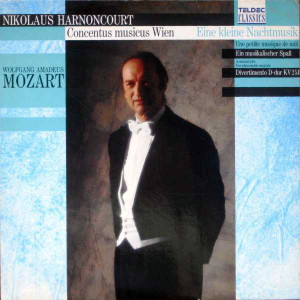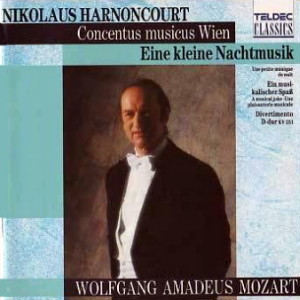 |
1 LP -
244 809-1 AZ - (p) 1989
|
 |
| 1 CD -
244 809-2 ZK - (p) 1989 |
|
| Wolfgang
Amadeus Mozart (1756-1791) |
|
|
|
|
|
|
|
| Eine kleine Nachtmusik G-dur,
KV 525 |
|
21' 21" |
|
| - Allegro |
8' 26" |
|
A1 |
- Romance:
Andante
|
4' 56" |
|
A2 |
| - Menuetto: Allegretto -
Trio |
2' 16" |
|
A3 |
| - Rondo: Allegro |
5' 43" |
|
A4 |
| Divertimento
D-dur, KV 251 "Nannerl-Septett" |
|
24' 59" |
|
| - Molto allegro |
6' 07" |
|
A5 |
| - Menuetto - Trio |
3' 46" |
|
A6 |
| - Andantino |
5' 06" |
|
A7 |
| - Menuetto (Tema con
Variazioni) |
3' 52" |
|
B1 |
| - Rondo: Allegro assai |
5' 35" |
|
B2 |
| - Marcia alla francese |
1' 33" |
|
B3 |
| Ein
musikalischer Spaß F-dur, KV 522
"Dorfmusikanten-Sextett" |
|
22' 44" |
|
| - Allegro |
5' 17" |
|
B4 |
| - Menuetto: Maestoso - Trio |
7' 00" |
|
B5 |
| - Adagio cantabile |
6' 38" |
|
B6 |
| - Presto |
3' 49" |
|
B7 |
|
|
|
|
CONCENTUS MUSICUS
WIEN (mit
Originalinstrumenten)
|
|
| -
Erich Höbarth, Violine |
-
Johannes Flieder, Viola |
|
| -
Alice Harnoncourt, Violine |
-
Kurt Theiner, Viola |
|
| -
Andrea Bischof, Violine |
-
Lynn Pascher, Viola |
|
| -
Anita Mitterer, Violine |
-
Rudolf Leopold, Violoncello |
|
| -
Peter Schoberwalter, Violine |
-
Herwig Tachezi, Violoncello |
|
| -
Karl Höffinger, Violine |
-
Eduard Hruza, Violone |
|
| -
Peter Matzka, Violine |
-
Andrew Ackermann, Violone |
|
| -
Sylvia Iberer, Violine |
-
Hans Peter Westermann, Oboe |
|
| -
Maighread McCrann, Violine |
-
Andrew Joy, Horn |
|
| -
Herlinde Schaller, Violine |
-
Charles Putnam, Horn |
|
| -
Philipp Saudek, Violine |
|
|
|
|
Nikolaus
Harnoncourt, Leitung
|
|
|
Luogo
e data di registrazione
|
| Minoritensaal,
Graz (Austria) - giugno 1988 |
|
Registrazione
live / studio
|
| studio |
Producer
/ Engineer
|
Wolfgang
Mohr / Helmut Mühle / Michael Brammann
|
Prima Edizione CD
|
| Teldec
- 244 809-2 ZK - (1 cd) - 70' 30" - (p)
1989 - DDD |
Prima
Edizione LP
|
| Teldec
- 244 809-1 AZ - (1 cd) - 70' 30" - (p)
1989 - Digital |
|
|
Notes
|
The works of music
that were composed for festive social
events, special family occasions and
social gatherings of the most varied
kinds are literally innumerable: they
bear such titles as Divertimento,
Serenade or Parthie (Suite). This
custom was upheld with particular
fondness in Salzburg, the birthplace
of Wolfgang Amadeus Mozart. Certain
models were well established: forms
with any number of movements, some
dance-like in character, some tending
more towards the sonata genre.
A splendid opportunity for a young
composer to experiment! And Mozart was
just this when he
composed his DIVERTIMENTO IN D K. 251
in 1776, at the age of twenty. He had
already progressed beyond the tone of
casual entertainment hitherto typical
of the divertimento genre, and wrote -
not without thoroughness - charming
“character” pieces, full of new sounds
achieved by the combination of wind
and string instruments, harmonically
expansive, and not infrequently
borrowing melodies from Austrian folk
songs.
"... it’s safe to say that his
development as a composer was complete
at the age of 20..." - thus Mozart’s
contemporary and his first biographer,
Franz Xaver Niemetschek. The
Divertimento à 7
stromenti, K. 251, offers confirmation
of this. The work has gone down in
Mozart literature as the "Nannerl
septet". It was composed
in all probability for the name-day of
Mozart’s sister Nannerl (26th July),
and received its first performance the
evening before. K. 251 could, however,
also be the “finale musick with the
Rondeau at the end” that was “produced
tolerably well” at the end of semester
celebrations at Salzburg University in
1777. Neither version is documented.
There is, however, evidence in the
form of the surviving autograph
manuscript for the fact that the
divertimento, which was composed in
"Luglio 1776", i.e. at the same time
as the Haffner Serenade, K.
250, was written down at great speed -
a brilliant piece of occasional music,
in which elements of the French style
(Marcia alla francese) are combined
with south German song melodies
(Menuetto and Rondo), and the
instruments blend together to produce
a witty chamber sound.
In Vienna ten years later, between the
much acclaimed Prague premiere of "Le
nozze dl Figaro” on
17th January 1787 and the no less
successful première of
“Don Giovanni" on 29th October of the
same year, Mozart entered in his
catalogue of works on 14th
June "EIN MUSIKALISCHER SPASS" (A
musical joke). After the composers
death, the work was given the
confusing title
“Dorfmusikanten-Sextett" (Village
musicians sextet), as if Mozartwas
poking coarse fun at the tradition of
rural music-making. In
tact, quite the contrary is true. With
subtle irony, unrepressed humour and
obvious pleasure at his own joke,
Mozart caricatures his fellow Viennese
composers - their technical clumsiness
and their lack of imagination and
sensitivity. A brilliant example of a
work without inner logic, full of
shallow pathos, wrong harmonies and
meaningless melodic progress - simply
a masterly “musical joke"!
The occasion of the work’s
composition and the date ofthe first
performance are unknown, as they are
too in the case of EINE KLEINE
NACHTMUSIK, which is documented on
10th August 1787. This well-known and
much-loved composition originally
consisted of five sections, but the “Minuet
and Trio" placed after the allegro has
been lost. The four surviving
movements are written with particular
care in Mozart's
best handwriting; E. F.
Schmid calls the piece
“probably his most popular
instrumental world". In
it, Mozart combines the festive
splendour of the allegro with the
spiritual charm of the rninuet; in the
romanze he conjures up words he wrote
to his father (4th April 1787) as the
latter lay on his death bed: "...
death (is) the true ultimate aim of
our lives... its image brings peace
and comfort too, and is the hey to our
true happiness"; and in the rondo
finale he demonstrates his brilliant
mastery of contrapuntal writing.
Nele
Anders
Translation: Clive Williams
|
|
Nikolaus
Harnoncourt (1929-2016)
|

|

|
|